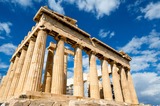
This is a breakout lesson created for a 6th grade unit on Ancient Greece.
- Subject:
- Ancient History
- Material Type:
- Activity/Lab
- Assessment
- Game
- Unit of Study
- Author:
- Jennifer Neset
- Date Added:
- 04/28/2021

This is a breakout lesson created for a 6th grade unit on Ancient Greece.

This resource is useful for students who can visit rare books in special collections libraries. Teachers and students of book history, literature, and art history might find this resource useful.
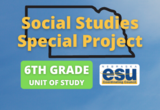
Does Alexander deserve to be called “The Great?” This inquiry leads students through an investigation of Alexander the Great using a variety of sources to analyze his impact on other cultures, his success as a military general, followed by his lasting impacts on the ancient world. Resource created by Sydney Daly, Millard Public Schools, as part of the Nebraska ESUCC Social Studies Special Projects 2024 - Inquiry Design Model (IDM).
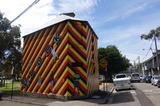
For this project, student will create a video about an ancient civilization. The video should include information such as time period, geography as well as other information such as type of government, technologies used, art created, and political influence.

An inquiry-based unit that teaches the use of primary source analysis through artifacts from Ancient Egypt. Students are asked to analyze artifacts from their own family, analyze artifacts from King Tut’s tomb, and then create hypotheses about what we can learn from ancient artifacts. Finally, students will construct an argument and create a press release.
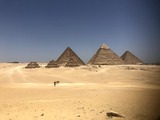
Three separate lessons covering the farming, trading, and geography of Ancient Egypt. Perferct for the beginning of studying Egypt in 6th grade. Each lesson includes pictures, articles, vocabulary to front load, and a quiz. The quizzes have both multiple choic and open ended questions.
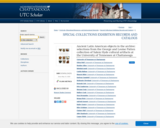
Early in the Spring 2020 semester, University of Tennessee at Chattanooga students in my Ancient to Modern Latin American Visual Culture Art History course embarked upon an intensive first-hand visual analysis and research project that involved working directly with original artifacts from Ancient Latin America housed within the University of Tennessee at Chattanooga Library’s Special Collections. This unique opportunity and the publication of their findings were made possible thanks to the generous support and assistance of Special Collections Director Carolyn Runyon and her dedicated staff.
By examining the wide array of Pre-Columbian objects in the George and Louise Patten Salem Hyde Papers and Cultural Artifacts Collection, these upper division students formed small research groups dedicated to specific artifact types, such as human figurines, animal figurines, tools and lithics, vessels, anthropomorphic ceramics, replicas, and sherds. They carefully recorded their original observations of their selected objects of study in written field notes, photographs, and drawings. Later, they compared their initial observations with preliminary collection data developed independently by Archaeology students of Dr. Andrew Workinger, leading to further questions and insights surrounding these extraordinary pieces predominantly from pre-contact indigenous cultures of the Central and Intermediate regions of Latin America that today comprise Costa Rica, Ecuador, Panama and Colombia. Building upon their analysis, the Art History student research groups then re-examined their selected artifacts through analytical frameworks focused on Gender and the Body, Color, Pattern and Materiality, Spirituality and the Object, Form and Function, and Identity and Representation. In presenting their findings to their peers, students received feedback that allowed them to refine their analysis and develop the original individual and group catalog essays that comprise this exhibition publication. Their research sheds further light on the extraordinary value and diversity of the ancient artifacts of Latin America that uniquely form part of UTC’s Special Collections, as well as the innovative power of interdisciplinary research and collaboration.
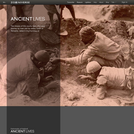
For classics scholars, the vast number of damaged and fragmentary texts from the waste dumps of Greco-Roman Egypt has resulted in a difficult and time-consuming endeavor, with each manuscript requiring a character-by-character transcription. Words are gradually identified based on the transcribed characters and the manuscripts' linguistic characteristics. Both the discovery of new literary texts and the identification of known ones are then based on this analysis in relation to the established canon of extant Greek literature and its lexicons. Documentary texts, letters, receipts, and private accounts, are similarly assessed and identified through key terms and names. Furthermore, an immense number of detached fragments still linger, waiting to be joined with others to form a once intact text of ancient thought, both known and unknown. The data not only continues to reevaluate and assess the literature and knowledge of ancient Greece, but also illuminates the lives and culture of the multi-ethnic society of Greco-Roman Egypt.
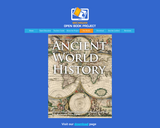
Seventh grade students will review the tools and mental constructs used by historians and geographers. They will develop an understanding of Ancient World History, Eras 1 – 4. Geography, civics/government, and economics content is integrated throughout the year. As a capstone, the students will conduct investigations about past and present global issues. Using significant content knowledge, research, and inquiry, they will analyze the issue and propose a plan for the future. As part of the inquiry, they compose civic, persuasive essays using reasoned arguments.
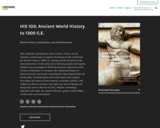
This textbook is divided into three sections: Africa, Asia & Americas, and Europe. It explores the history of the world from pre-historic times to 1300 C.E., paying specific attention to the interconnections (or disconnections) between peoples and regions. Students are encouraged to think beyond their experiences with western civilizations to recognize the widespread impact of historical events and trends, including how they helped shape the world today. Touching upon each world region, the readings investigate the impact of environment, economics, politics, and religion on diverse societies. Key topics are sites of change and integration such as the rise of cities, religion, technology, migration and trade, the spread of disease, gender relationships, warfare and social movements.
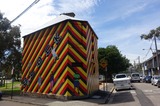
This 6-week course centers on the origins of human beings and the emergence of civilization and includes the study of India, Greece, and Rome as seen thought the development of democratic forms of government.

Short Description:
The Ancient & Medieval World is a collaborative, open educational resource designed to help students better understand a world long removed from their contemporary experience. The text uses a modular format where students are provided with a brief introduction to each theme, several primary sources, interpretive material written by subject-matter experts, relevant maps and timelines, and visual sources, as well as a glossary of unfamiliar terms. Each module can be used as the foundation of a course assignment or thematic lesson.
Word Count: 75897
ISBN: 978-1-989864-59-3
(Note: This resource's metadata has been created automatically by reformatting and/or combining the information that the author initially provided as part of a bulk import process.)

Explore the physics and material science of making stone tools. Educator Nate Salzman walks us through the surprisingly complex science of flintknapping, or the process of turning stone into blades, arrowheads, spear points, axes, jewelry and more. Making tools from stone may be thousands of years old, but required people to think about the properties of the material they were using and the physics of striking the stone to shape it just right.NOTE: These are animations derived from the video "The Science of Knapping" which is linked here and published under its own listing on OER Commons.This resource is part of Jefferson Patterson Park and Museum’s open educational resources project to provide history, ecology, archaeology, and conservation resources related to our 560 acre public park. More of our content can be found on YouTube and SketchFab. JPPM is a part of the Maryland Historical Trust under the Maryland Department of Planning.
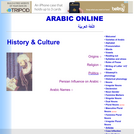
This webpage provides elementary information on aspects of Arab culture and history, including religion, politics, naming conventions, and Persian influence on Arab culture and language. The information seems to have been authored by the site's administrator, and contains no references or citations.

Nearly Everything You Need To Know About the Aztecs Can Be Found Within the Sacred Precinct.
This engaging video examines the most important part of the entire Aztec world: the literal center of the Universe: The Sacred Precinct of Mexico-Tenochtitlan. Now, nearly everything you need to know about the Aztecs can be found within this sacred space located in the center of its majestic city: Tenochtitlan. There’s about 78 structures, although all of them haven’t been found yet…. But these buildings can you teach you nearly everything… about the Culhua Mexica. You can learn about Aztec religion…. Social structure… architecture… engineering… sports… their cleanliness.
Model of Sacred Precinct is located at the Mexican National Museum of Anthropology and History.

This is the story of the Aztec’s historic 200+ year pilgrimage, as told from the 16th Century Primary source: The Codex Boturini.
The Aztecs came from a place in the north called: Aztlan, which means, “place of the White Heron.”
The Aztecs left their homeland Aztlan in about 1111 C.E. After more than 200 years of trials and tribulations, they stopped when they saw their sign from their god Huitzilopochtli: the eagle perched on the cactus. There, they would build one of the greatest cities in world history.
This is the story of their historic migration from Aztlan to Tenochtitlan in their own words.
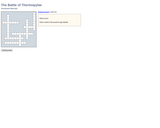
This is a crossword that will help students of grade 7 to remember some essential details for the battle of Thermopylae, a very important lesson regarding ancient Greek history.

Long Description:
The Biographical Dictionary of the History of Paleoanthropology is an ongoing digital humanities project by Dr. Matthew Goodrum, a historian of science who teaches in the Department of Science, Technology, and Society at Virginia Tech. The work contains biographies of individual paleoanthropologists, especially those for whom little information exists in English. They are organized in alphabetical order. Each biography is subject to revision as new information comes to light, and new biographies will be added over time.
Word Count: 92962
(Note: This resource's metadata has been created automatically by reformatting and/or combining the information that the author initially provided as part of a bulk import process.)

The Children’s Hour has produced a six part podcast and curriculum series on the history of the American Southwest, in partnership with the Center for New Mexico Archaeology, the Native American Community Academy (NACA), NACA Inspired Schools Network, and numerous others.Typically a region of the US that is overlooked in textbooks, the Southwestern United States history begins 23,000 years ago in what is now know as White Sands National Park. Students will learn how the area was settled, from its Indigenous beginnings through the brutal era of Colonization by Spain, and then the United States, and finally emerging into statehood. This series highlights the moments that changed the history of this region and this nation forever.The series comes with a free, download-able Learn-Along Guide that meets and cites US national education standards for elementary through high school students. Our production began with “virtual field trips” for students that include expert interviews to better understand each time period. Students can hear the full conversations with our experts by watching the field trips at The Children's Hour YouTube page.Join us, and learn about our fragile, and deeply rooted story of our high desert region over six episodes, and through our Learn-Along guide.
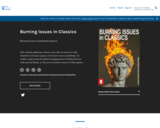
This volume addresses various ways that we interact with, refashion and reuse aspects of ancient Greece and Rome. Its studies range from the political engagement of Italian fascists with ancient Rome, to the use of ancient Greece in video games. The chapters each take on a ‘burning issue’ of identity or ownership, that is, how we identify with ancient Greeks and Romans, as well as drawing (often troubling) elements of our identity from them. In addition, they address the question: which of us feel that we own the past? Does Classics belong to everyone, or has it been coopted by an elite few?